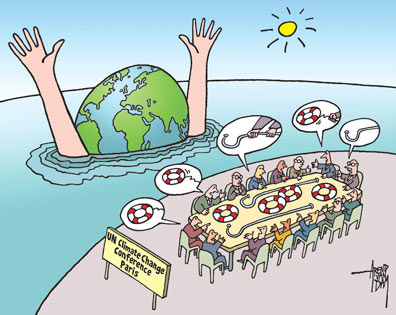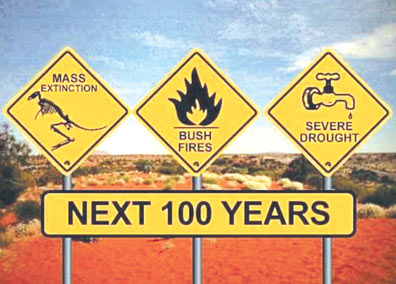Sri Lanka's resilience agenda
A four-point program was presented during COP 21 on
climate proofing the island nation.:
by Rukshana Rizwie

|

Prof. Mohan Munasinghe
- cinnamongrand.org |
After 20 years of failed negotiations, a global climate deal brokered
by the 21st Conference of the Parties in Paris (COP21) may mean a lot to
a world that had waited for consensus on dealing with impacts of climate
change.
As COP 21 got underway in Paris, Sri Lanka has submitted a structured
Greenhouse Gas (GHG) emission reduction plan, referred to as the
Intended Nationally Determine Contribution (INDC) along with 183 other
countries.
For a country that has heavily relied on the use of fossil fuels in
the past and continues to do so, the INDC is a well-crafted ambitious
plan. Sri Lanka has submitted its INDC under four areas:
Mitigation: The reduction of Greenhouse Gas (GHG) emissions in the
sectors of energy, transportation, industry, waste and forestry
Adaptation: Mainstreaming climate change adaptation into main
economic drives with attention to economic and livelihood
diversification. Adaptation measures will focus on sectors of food
security, health, water, coastal and marine resources as well as
infrastructure and human settlements.
Loss and damage: A local loss and damage mechanism to be developed to
alleviate the livelihoods of those who have been affected.
Means of implementation: External support for finance, technology
transfer and capacity building
In order to accomplish the above ambitious goals, Sri Lanka will need
to turn over a new leaf. The mitigation strategies for the energy sector
detailed in the INDC calls for a 3% conditional and 7% unconditional
emission reduction against the Business as Usual (BAU) scenarios.
A reality check
The transport sector alone cites an overhaul where public
transportation will be green- fuelled, a reduction of unproductive
transport system, switching passengers from private to public modes of
commuting and increasing the efficiency and quality of public
transportation. The proposed 'Western Region Megapolis' which is to be
unveiled in January next year is an example of how mitigation strategy
will be put in place.
 Among the other sectors cited in the INDC, Sri Lanka envisions to
increase the forest cover which is at 29.6% at present to 32%. In the
waste sector, although Sri Lanka generates 6500-7000Mt per annum,
collection stands at only 39%. This collection rate is to be increased
to a range between 50% and 65% by promoting waste separation, recycling,
composting and waste-to-energy. Among the other sectors cited in the INDC, Sri Lanka envisions to
increase the forest cover which is at 29.6% at present to 32%. In the
waste sector, although Sri Lanka generates 6500-7000Mt per annum,
collection stands at only 39%. This collection rate is to be increased
to a range between 50% and 65% by promoting waste separation, recycling,
composting and waste-to-energy.
Meanwhile, the industrial sector will need to gear up for a swift
modernization and follow recognized standards. Fuel switching and tax
structures are already being looked at as pragmatic measures.
"The irony and injustice of climate change is that it is felt most by
the poor countries with a low carbon footprint," said Prof. Mohan
Munasinghe, the Vice Chair of the UN Intergovernmental Panel on Climate
Change (IPCC). World Bank statistics show that, in 2011, Sri Lanka's
carbon dioxide emissions were 0.73 metric tons per capita, while India's
emissions were 1.66 metric tons, Maldives' at 3.26 metric tons and
Pakistan's 0.94 metric tons. China emits 6.71 metric tons per capita
which by far is the highest in the region.
Prof. Munasinghe lamented that the impacts of climate change is "real
and here to stay" and it was high time that governments understand the
gravity of the situation to the point that it is imperative to "climate
proof" national development goals.
"Ideally we should be doing more," he said. "We have to make these
changes within a sustainable development framework."
Prof. Munasinghe recollected the 'sustainomics' theory which called
for a more holistic and practical synthesis that could make development
more sustainable.
The climate change expert also called on policy makers to focus on
efforts to "bend the curve" by finding the most efficient and
practicable to methods to achieve the sustainable development goals (SDGs)
"without looking at climate change in isolation."
The current context
While detailing the impact of climate change, Prof. Munasinghe cited
four main vulnerabilities that are more visible and in some places,
devastating. He cautioned that the nexus between water and the
agriculture sectors in the event temperatures go up, resulting in
prolonged droughts that could precipitate a food crisis.
 The Intergovernmental Panel on Climate Change - a scientific body set
up through the United Nations - predicted that crop yields in South
Asian countries could plunge by 30 percent by the end of the century,
due to factors such as water scarcity. The Intergovernmental Panel on Climate Change - a scientific body set
up through the United Nations - predicted that crop yields in South
Asian countries could plunge by 30 percent by the end of the century,
due to factors such as water scarcity.
Predictions from the Department of Meteorology suggest that that
fluctuating monsoon patterns were caused by climate change could place a
heavy burden on already marginalized farmers.
"The trick would be to invest in drought resistant crops that can
survive the changing patterns of climate. There are several varieties of
rice that fit the bill," he said. "These are the types of adaptation
improvements that we should be considering as a nation."
He also mentioned the wet zone and the hill country which has already
felt the impacts of changing weather patterns in the form of consistent
floods and regular landslides.
"In Sri Lanka, the sea level has gone up by 17cm. within the last 100
years," he said, on a note of caution, adding that rapid expansion and
developmental activities -particularly in the coastal areas and within
the burgeoning tourism industry - requiring urgent review. |

